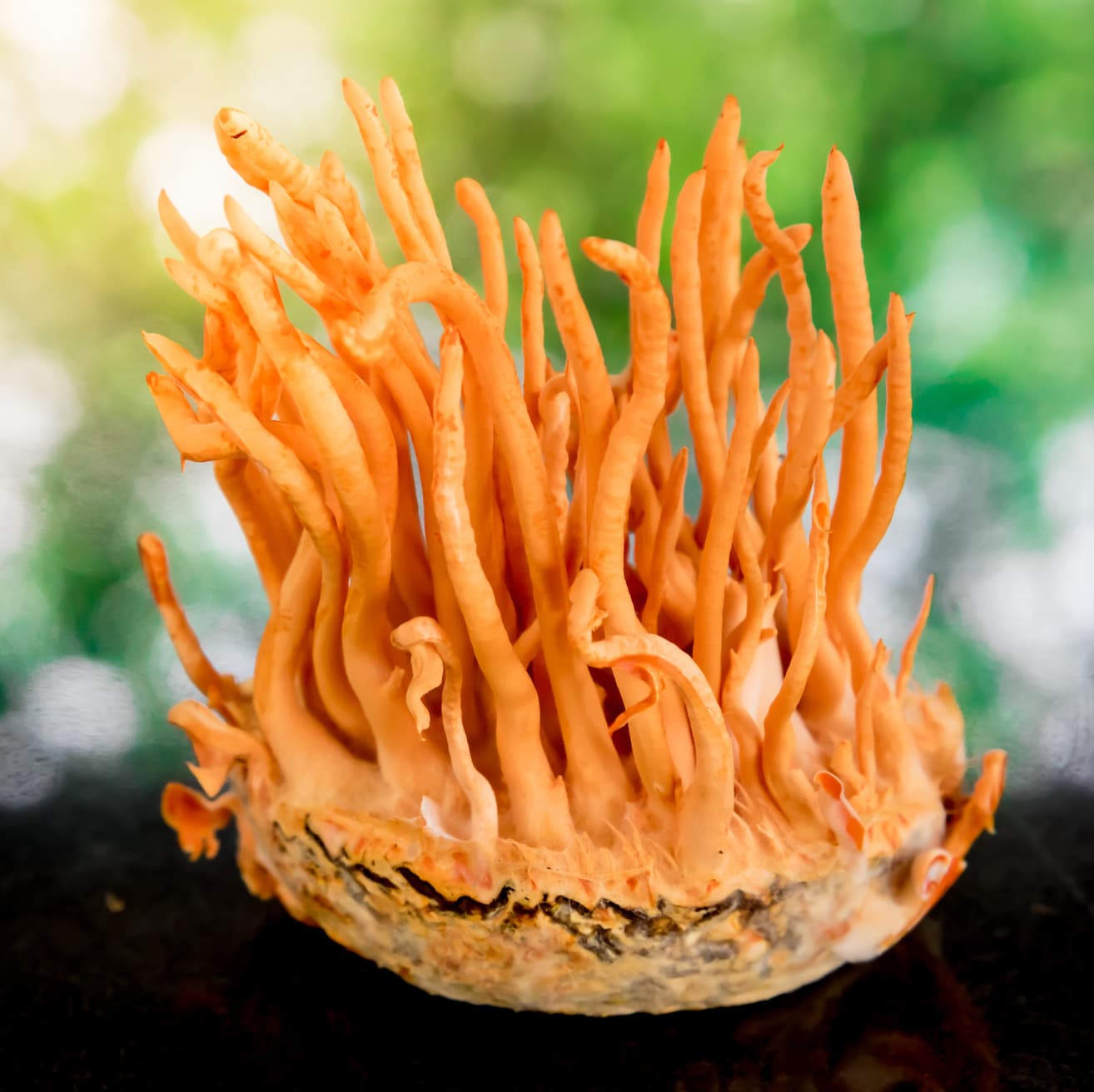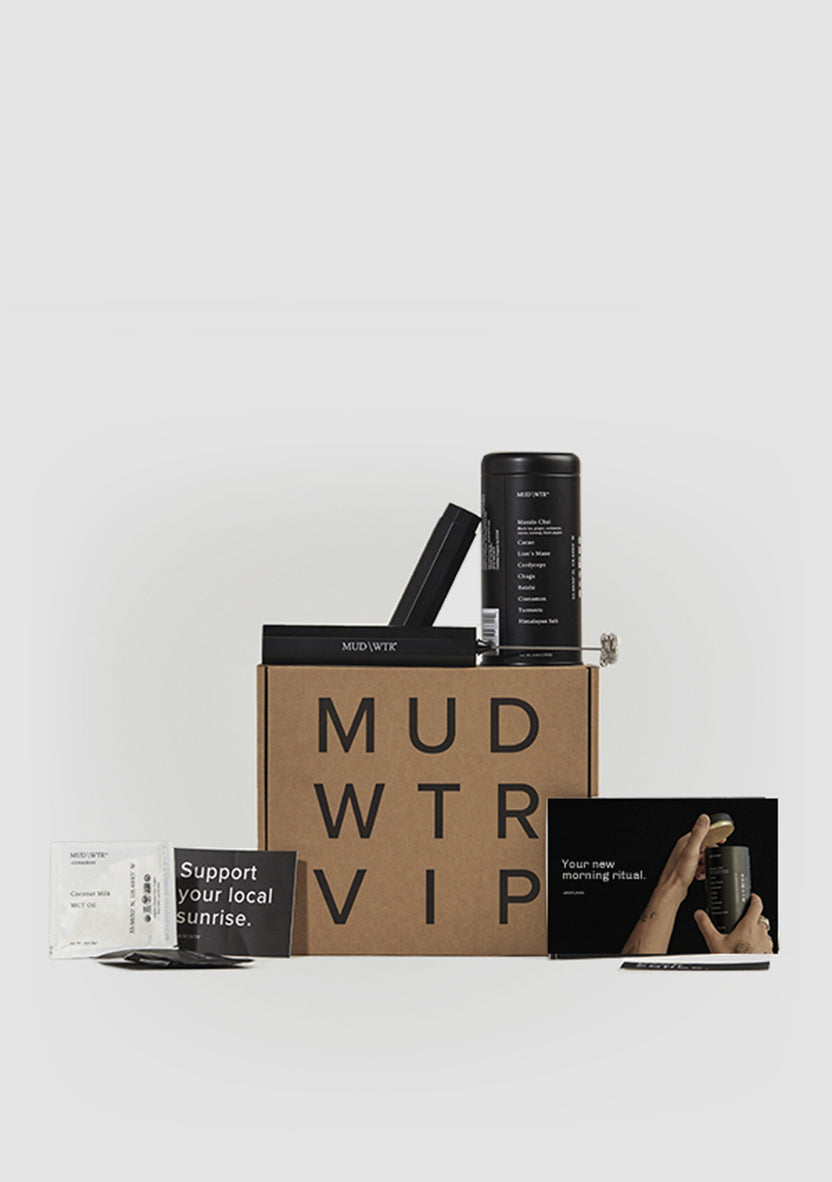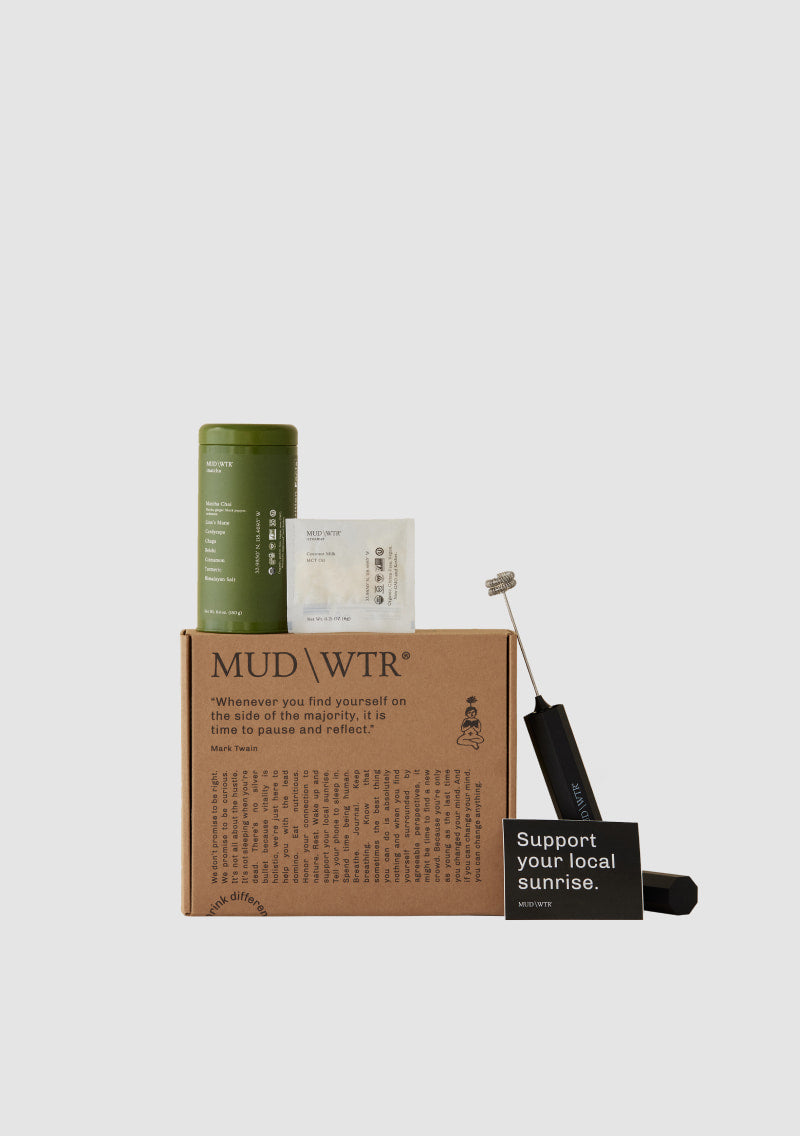About Our Mushrooms
So you wanna know more about MUD\WTR's mushrooms? We thought you'd never ask. Here’s everything you need to know.
Still have questions? We love chatting about ’shrooms. Reach out at drink@mudwtr.com.

Cordyceps
Where are MUD\WTR’s mushrooms grown?
Our mushrooms are grown at M2 Ingredients, a USDA-certified organic indoor mushroom farm in Carlsbad, California.
But why does it even matter where they grow?
One word: quality.
See, mushrooms are bio-accumulators. That means they consume their environment—including the air, heavy metals and pollutants. Bottom line: If it's in the environment, it's in the mushrooms that grow there. All of our mushrooms go through in-house and third-party testing for heavy metals and other contaminants before they leave the mushroom farm.
But why an indoor farm? Shouldn’t mushrooms grow in nature?
Wild fungi are an essential part of any ecosystem. And that’s a big part of why it’s better for us to use indoor-grown mushrooms in MUD\WTR’s products. Harvesting wild mushrooms at scale could potentially be unsustainable and damaging to the environment if not done consciously and correctly. Top-notch indoor mushroom farms are a great way to ensure sustainability and quality (and keep our ’shrooms free of insects, pesticides and other environmental pollutants).
Plus, there's that whole bio-accumulation thing.
OK, cool. Indoor mushroom farms sound dope. But what’s up with growing mushrooms on oats?
Like all living organisms, mushrooms need nutrients to grow. The substrate on which mushrooms grow provides them with the nutrients they need. This substrate can be a number of materials—mushrooms aren’t extremely picky, but what's important is that they have proper nutrition available to them. The key to ensuring that a substrate isn’t present in a full-spectrum mushroom ingredient is time. Our grower lets the mushrooms complete their full growth cycles, meaning they continue to grow the mushroom until they produce big, beautiful fruiting bodies for most species, and the mycelium has digested the substrate (in this case, the oats).
Our U.S. grower has tested multiple substrates, measured the growth of the mushrooms and the development of the beneficial compounds, and found oats to be top of the list.
Wait. Are there oats in your products?
We do not add raw oats as filler or to bulk up our products, period. We want to give you the best product possible, not a blend of mushrooms and mycelium and unfermented oat substrate. That's why we work with a top-notch U.S.-based mushroom and mycelium grower with a pile of certifications and some of the smartest mycologists in the country on their books. They grow their fungi for the full life cycle, allowing the substrate to be myceliated, fermented and digested.
As a Whole30 Approved® product, there's no raw, undigested grain or gluten to be found. While some cultivators stop the growth process early (prioritizing money over scientific research), our mushrooms grow through their entire life cycle, with the mycelium digesting the substrate before we process it into a powder.
For extra nerd points, we DNA test all of our mushrooms to ensure they are what they say they are.
Why do you use whole mushroom powders instead of mushroom extracts? What's the difference?
There's a lot of misinformation going around about extracts versus whole mushroom powders. Yes, we use whole mushroom powders instead of extracts, but rather than drag extract-based products through the mud (heh), here's an unbiased breakdown of the differences between extracts and whole mushroom powders.
Fruiting body extracts and whole mushroom powders are both beneficial, but they play different roles when it comes to our health. Extracts are promising for targeted medical applications, while whole mushroom powders—including the mycelium and the fruiting bodies—are great for everyday use and overall body wellness. This includes promoting focus, a healthy immune system and digestive wellness.
The extreme processing of extracts can denature some compounds in mushrooms and, in some cases with larger molecules, filter them out and discard them. At MUD\WTR, the steam-heat activation step that we use prior to dehydration, as well as during milling, further softens the chitin in the mushrooms and allows for bioavailability of the efficacious and nutritional compounds. Wait, what is chitin?! It’s a fibrous substance forming the cell walls of fungi. So, essentially, this steam helps soften the ’shroom.
Though extracts may denature and remove large parts of what mushrooms and mycelium have to offer, they are very effective at concentrating specific active compounds. With full-spectrum powders, the small set of active compounds are present, but you get a larger dose of them with extracts, at the expense of other macromolecules.
So, the truth is this: You're not getting everything ’shrooms have to offer by exclusively consuming extracts or just full-spectrum powders that include mycelium. We fully support using both preparations of mushrooms—it’s the only way to get the most from our fungi friends.
Fruiting bodies and mycelium. What?
Fruiting bodies are the spore-producing organs of a fungus, often seen as a mushroom or toadstool. Mycelium is the vegetative part of a fungus, comprising a network of fine, white filaments (we call ‘em hyphae). Both the fruiting bodies and the mycelium of the mushroom contain beneficial bioactive compounds.
Unfortunately, mycelium is currently on the end of a smear campaign, and its bad rap comes from half-truths spread by some extract manufacturers. The true part is that there is potential for poorly grown mycelium, which is made up primarily of the undigested substrate, to hit the market and be labeled as beneficial. Some misleading marketing campaigns lump all mycelium-based powders in with those bad manufacturers. In fact, fruiting body extracts can also be made poorly. Ask certain extract brands how much dextrin they use in their extracts. (It's not labeled, and it's often not zero.)
Fortunately, MUD\WTR partners with a top U.S.-based mycelium and fruiting body grower to ensure our mushrooms are fully grown and the substrate is digested before it's turned into a powder. You'll find no raw fillers here.

Your mushroom product checklist
We love mushrooms. And we love you. So we want you to have all the info you need to decide for yourself which products to buy.
Here are some questions to ask any company before buying a mushroom-based product:
• Where are your mushrooms grown?
• If they're grown indoors, what substrate do you use?
• If your mushrooms are wild harvested, what are you doing to monitor and mitigate the environmental impact?
• Do you test for heavy metals?
• Are your mushrooms allowed to complete their full life cycle and fully digest their substrate before harvesting?
• Do any of your products contain the filler dextrin? If so, how much, and why?
Still have questions? We love chatting about ’shrooms. Reach out at drink@mudwtr.com.
Which mushrooms does MUD\WTR include in its products?
While different needs call for different ’shrooms, we use eight different adaptogenic mushroom species in our products. All of our organic mushroom powders (except for chaga) contain both mycelium and fruiting bodies.
Reishi
Known as the "King of Mushrooms," reishi (Ganoderma lucidum) is real superstar. It’s long been used to support our bodies' adaptability to stress and immune system functionality, and is a great all-around mushroom for daily use.
During growth, masses of reishi fruiting bodies emerge in an elongated antler shape, growing from and covering the exterior surfaces of the mycelial blocks. The hard and fibrous fruiting bodies make the dehydration and milling of the biomass a challenge, and the fruiting bodies provide bitter-tasting triterpene compounds. The sweeter and milder tasting mycelium in the finished mushroom powder moderates the bitter taste of the fruiting bodies.
Find it in:
:rest Rooibos | :rise Matcha | rise: Cacao | :balance Turmeric | :mushroom boost
Lion's Mane
Lion's mane (Hericium erinaceus) is a beautiful, white-capped fungus that often grows in clusters on trees. It’s used in traditional Chinese medicine for promoting cognition and focus.
During growth, masses of fruiting bodies cover the exterior surfaces of the mushroom blocks at maturity. The mycelium contains nootropic erinacine compounds, while the fruiting bodies provide nootropic hericenone compounds. This is one mushroom where you’re actually missing out quite a bit on the benefits if you don’t consume the mycelium!
Find it in:
:rise Matcha | :rise Cacao | :balance Turmeric | :mushroom boost
Chaga
Chaga (Inonotus obliquus) is a mushroom found predominantly in cold climates. In nature, it grows on birch trees and the sterile conks have a dark, rough exterior. Chaga is well-known for its medicinal properties and has been used for centuries in Eastern Europe and Russia for its antioxidant properties. It’s also believed to support immune system function.
Our organic chaga mushroom powder does not contain the classic conks that you would see on birch trees. Instead, our growth contains the mycelium and the very small fruiting bodies that are typically hidden beneath the bark of the birch tree. In nature, wild chaga fruiting bodies are inconspicuous, seldom spotted and quickly consumed and disseminated by forest insects. The conks that you see on the tree are in fact growths of mycelium mixed with wood from the tree, not fruiting bodies.
Chaga grows vigorously on an organic oat substrate and does a thorough job of enzymatically digesting the oats, converting them into a very hard and solid block of mycelial biomass.
Find it in:
:rise Matcha | :rise Cacao | :balance Turmeric | :mushroom boost
Cordyceps
Cordyceps (Cordyceps militaris) is a unique and potent fungus. It has been used in traditional Chinese medicine for centuries, primarily to support the immune system and provide antioxidant effects.
During growth, masses of many small and lightweight orange-colored fruiting bodies form on the outer surfaces of the brilliantly orange-colored mycelial blocks. Cordyceps militaris produces higher levels of active ingredients than Cordyceps sinensis, both in the wild and in man-made cultivations.
Find it in:
:rise Matcha | :rise Cacao | :balance Turmeric | :mushroom boost
Turkey Tail
Turkey tail is a mushroom that is found all over the world. It’s a popular culinary mushroom, but is also well-known for its medicinal properties. Turkey tail is a great source of antioxidants and offers support for immune system function. It’s also known as Trametes versicolor. (Yep, the mycologists naming this one brought their A-game).
As implied, the fruiting bodies of this mushroom look like a wild turkey's tail, and the species name versicolor means “many colors.” The fruiting body has concentric arches of white, black and various shades of brown, red and green. Turkey tail contains baicalein and quercetin, two powerful antioxidant flavonoids.
Find it in:
King Trumpet
The benefits of the king trumpet mushroom are vast. This fungi is packed with nutrients like protein, fiber, and vitamins B1, B2 and D, as well as important minerals like potassium, magnesium and zinc.
In nature, king trumpet mushrooms (Pleurotus eryngii) grow in clusters on the stumps or logs of deciduous trees. The caps of the mushrooms can range in color from white to brownish-gray, and the stems are typically white.
Find it in:
Maitake
Maitake mushrooms are a type of fungi that are known for their health benefits. They support immune system function and contain potent antioxidants.
In nature, maitake mushrooms (Grifola frondosa) grow in clusters at the base of trees, typically oak trees. The fruiting bodies of the maitake mushroom emerge from late summer through the fall months. The mushrooms can be identified by their characteristic fan or shell-like shape, and are light-to-dark brown in color with a hairy surface. The gills on the underside of the mushroom release spores, which are responsible for reproduction.
During growth, mushroom spores land on dead wood or compost and begin to germinate. Mycelium, the vegetative part of the fungus, grows through the substrate and colonizes it. Fruiting bodies then form as the mycelium reaches maturity. In order for maitake mushrooms to fruit optimally, temperatures between 60 to 70 degrees Fahrenheit are necessary, with high humidity levels (80% or higher).
Find it in:
Shiitake
Shiitake mushrooms have been used for centuries in Asia for medicinal purposes. In recent years, they’ve become increasingly popular in the United States. This species of mushroom is a good source of antioxidants and B vitamins, including niacin (which promotes healthy skin and hair) and biotin (which helps keep the nails strong). Shiitake mushrooms are also a good source of minerals, including potassium and selenium.
The cultivation of shiitake mushrooms (Lentinula edodes) dates back to China in the early 1900s. In America, the first commercial crop was grown in Oregon in 1978. The growing process of shiitake mushrooms is similar to that of other fungi. Shiitake spores are germinated on sterilized grains or sawdust blocks, then transferred to larger containers as they grow. The fruiting body or cap of the mushroom will form within 10 to 14 days if the proper environmental conditions are met: temperatures between 60 to 70 degrees Fahrenheit with high humidity levels (85-95%).
Find it in:
Try a starter kit today
BEST WAY TO GET STARTED











